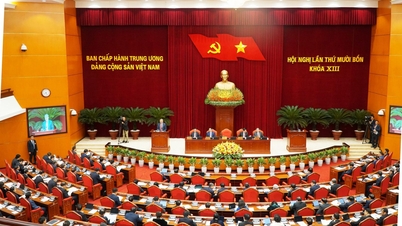Since the economic turmoil of 2008–2009, the Government has repeatedly initiated economic restructuring programs, rekindling the story of growth model innovation.
By 2021, Resolution 31/2021/QH15, the National Assembly officially set the goal: "Restructuring the economy associated with renewing the growth model towards ensuring macroeconomic stability, improving productivity, quality, efficiency and competitiveness based on science , technology, innovation and high-quality human resources."
According to the Resolution, average labor productivity (NSLD) must increase by over 6.5%/year, total factor productivity (TFP) contributes 45% of GDP, aiming for 1.5 million enterprises, and digital economy reaches 20% of GDP by 2025. These are targets demonstrating the ambition to rise to the group of upper-middle-income countries.
But in reality, the gap between resolutions and life is still large.

An economy that wants to “run fast” but whose engine is still weak, whose fuel is still expensive, whose technology is still old – cannot break through. Photo: Nam Khanh
According to the Government Report presented by Deputy Prime Minister Ho Duc Phoc to the National Assembly on October 20, of the 27 targets of the Resolution, so far only 10 targets are likely to be completed, 9 targets are difficult to achieve, and 4 targets are forecasted to not be completed.
The Government frankly acknowledged: “The economic structure and growth model have not shifted strongly; the development of the private sector is still limited; labor productivity has not met the requirements of the new stage.”
The National Assembly’s Economic and Financial Committee, through its review report presented by Chairman Phan Van Mai, also pointed out that the growth model is still slow to transform, still mainly relying on capital and labor; while sustainable driving forces such as innovation, science and technology, and knowledge economy have not made significant contributions. It is this dependence that has prevented Vietnam from shifting growth in depth, and the risk of getting stuck in the middle-income trap is increasingly clear.
Old engine
Looking back on the long journey, the Summary Report on 40 years of innovation serving the 14th National Congress recorded a great step forward in awareness: Vietnam has determined to shift from "breadth" to "depth" growth, based on science, technology, innovation, associated with green economy, circular economy, digital technology, and artificial intelligence.
But at the same time, this report also admitted: "Industrialization and modernization associated with growth model innovation and economic restructuring have not achieved the set goals." The goal of becoming a modern industrialized country by 2020 has not been achieved; the growth rate tends to decline in a 10-year cycle; productivity, efficiency, and competitiveness are all low; three strategic breakthroughs - institutions, infrastructure, and human resources - have not yet met expectations.
These numbers are not just a technical assessment, but an institutional warning: we are still growing with old drivers, while the world has moved to a model based on data, clean energy and innovation.
The Draft Political Report of the 14th National Congress further emphasized: “The improvement of development institutions is still slow; many laws, mechanisms and policies are still overlapping; productivity, quality, efficiency and competitiveness of the economy are still low; ICOR is still high (6.9); innovation of the growth model associated with economic restructuring is still slow; science, technology and innovation have not yet become the main driving force.”
An economy that wants to “run fast” but the engine is still weak, fuel is still expensive, and technology is still old – cannot break through.
New motivation
According to the Draft Political Report of the 14th National Congress, Vietnam will "establish a new growth model, restructure the economy, promote industrialization and modernization, taking science, technology, innovation and digital transformation as the main driving force."
The goal is to improve productivity, quality, efficiency and added value of the economy, create new production capacity with a focus on data economy, digital economy, green economy, new energy and new materials; form new growth poles and new-generation economic zones on par with the region.
However, to achieve double-digit growth as the target, the capital problem is a huge challenge. According to the Ministry of Finance’s calculations for a discussion of the Central Economic Committee, to increase GDP by 2.5–4 percentage points compared to the present (when productivity has not yet made a breakthrough), the total investment that needs to be mobilized must increase from 32.1% to 41.5% of GDP by 2030, equivalent to 1,774 billion USD in the period 2025–2030 – or about 262–296 billion USD per year.
Of which, public investment needs about 457–528 billion USD, FDI about 239–271 billion USD, and domestic private investment needs to mobilize up to 876–975 billion USD.
If public investment only reaches about 75% of the requirement, GDP growth could decrease by 1.63–3.9 percentage points, especially heavily in industry (-4.1 points) and construction (-8.9 points).
The report warns: high levels of public investment mobilization will put great pressure on fiscal balance; external borrowing sources are limited due to global trade tensions; government bonds may "crowd out" private capital; increasing regular budget revenue will eliminate consumer demand; and mobilization through one-time revenues from land, infrastructure, and real estate will create market instability.
In other words, capital-driven growth will be unsustainable and increasingly expensive. Knowledge-driven and institutional-driven growth is the only way for Vietnam to escape the low-productivity trap.
Innovation from new approaches
From Resolution 31/2021/QH15 to the 40-year Renovation Summary Report, and then to the Draft Political Report of the 14th National Congress, the consistent spirit remains: the growth model must be renewed. But without changing the way institutions operate, it will be difficult to initiate and unleash the "new driving force".
To change the growth model, we must start with the way we allocate resources: the State cannot be both a referee and a player. Science, technology and innovation must be considered a strategic investment item in the budget, not just a movement. Land institutions and capital markets must be reformed to pave the way for the private sector – the most important growth engine – to be promoted. And most importantly, decentralization – decentralization with accountability must become real, so that dynamic localities can form real growth poles, not administrative slogans.
So we cannot accelerate with old engines, and we cannot industrialize by mobilizing more gold or extending retirement ages.
An economy that wants to break through cannot rely on “idle resources among the people” or “a few more years of labor”, but must rely on intellectual resources and institutions – the only things that can create new productivity and new value.
If knowledge, science, technology and innovation do not become the foundation, “double-digit growth” is likely to occur in a few years and will hardly last in the long term, as the desired goal.
Innovating the growth model, in the end, is not about changing GDP targets, but about innovating development thinking, where the state creates an environment for creativity, businesses are freed, and people are able to unleash their true potential.
Source: https://vietnamnet.vn/doi-moi-mo-hinh-tang-truong-dong-co-moi-de-di-xa-2460622.html


![[Photo] Heavy damage after storm No. 13 in Song Cau ward, Dak Lak province](https://vphoto.vietnam.vn/thumb/1200x675/vietnam/resource/IMAGE/2025/11/08/1762574759594_img-0541-7441-jpg.webp)


























![[Video] Hue Monuments reopen to welcome visitors](https://vphoto.vietnam.vn/thumb/402x226/vietnam/resource/IMAGE/2025/11/05/1762301089171_dung01-05-43-09still013-jpg.webp)




































































Comment (0)